Abstract
Digital restoration has become an effective way to restore traditional costumes, but there are still problems such as low modeling efficiency and difficult pattern recognition. This study focuses on Tang Dynasty ladies in the “ramming & washing silk painting”, integrating AI + 3D technology with costume culture for comprehensive restoration. The methodology includes era-specific analysis for identity and body shape determination, image-based sizing, fabric identification, color matching, and pattern restoration using AI and edge-detection algorithms. Comparative analysis with original images guides 3D modeling and AI-assisted restoration of makeup, hairstyles, and accessories. The successful restoration of the lady on the left’s costume in the “ramming & washing silk painting” proves the effectiveness of this AI + 3D method in protecting and innovating traditional clothing.
1. Introduction
Chinese costume culture is one of the most notable and representative traditional Chinese cultures. Costumes can always be seen as two parts: the clothing and the makeup, which are inseparable and complement each other to create a shining example of Chinese culture. Due to the fact that ancient clothing was mostly made of natural materials such as cotton, linen, silk, and wool, it was easily damaged by factors such as material, age, environment, preservation techniques, restoration processes, and human factors. Additionally, makeup is particularly difficult to preserve besides metal accessories [1]. Based on this, many scholars have conducted research on ancient costumes adopting the method of cultural relic restoration, which is the process of reproducing the original appearance of cultural relics through the study of the cultural relics themselves and related materials, and make great contributions to the inheritance and innovative development of traditional costumes [2].
Globally, digital restoration practices have evolved significantly, yet gaps persist in achieving efficient modeling and accurate pattern recognition. International studies, such as those by Albu, A.V. et al. on traditional Romanian women’s shirt [3] and Tanaka on Japanese kimono digitization, highlight similar challenges in fabric pattern analysis and cultural context integration. These parallels underscore the universal need for advanced digital solutions in costume preservation.
With the widespread application of digital technology in the field of clothing, several academics have also begun to use digital technology to conduct research on traditional costumes. For example, Yu, L. took Dunhuang coffered patterns as the research object and used digital technology and software technology to establish a pattern database, empowering clothing design and application with digital technology, which is beneficial for the digital application and dissemination of traditional Chinese patterns in fashion design [4]. Starting from the digital display of clothing accessories, Liang, H.E. et al. explored more ways for museums in the Jiangnan region to display clothing accessories in terms of physical form, popularization of digitalization, and multimedia system display [5].
Applying digital technology for 3D virtual modeling and simulation of clothing, and carrying out digital restoration of traditional clothing, can not only achieve the repair of damaged clothing, but also improve work efficiency [6]. In recent years, many scholars have conducted digital restoration research on traditional clothing using 3D digital technology. Liu, K.X. et al. studied the style, structure, and size of the ladies’ dresses in the Hairpin Ladies’ Picture and used virtual fitting technology to restore the clothing [7]; Zhu, G.Z. et al. used digital technology to achieve three-dimensional digital restoration of Hakka cardigans and conducted a comprehensive evaluation of the restoration effect through a fuzzy comprehensive evaluation method [8]; Lin, C.J. mainly focuses on the form of music and dance costumes from the Qin Dynasty to the Qing Dynasty, and combines various methods such as literature review, image segmentation, 3D digital restoration, and questionnaire research to restore and study the form of costumes [9]; Zhu, C. et al. reconstructed the costumes of 12 ladies in the “ramming & washing silk painting” and summarized the overall idea of costume restoration, but lacked research on the details and restoration of the makeup [10]; Qiao, W. et al. used high-precision digital scanning and modeling techniques to digitally restore and explore costume in Qing Dynasty literati paintings [11]. It can be seen that digital technology has become one of the main means of restoring traditional clothing.
Digital technology is undoubtedly beneficial for the restoration of traditional clothing, but in the process of its application, it is even more important to pay attention to the standardization of principles and methods to avoid cultural relic damage caused by misuse of technology. When the China Silk Museum used 3D scanning as a digital technology to restore Qing Dynasty dragon robes, due to the large amount of gold thread embroidery on their surface, high-precision scanning was prone to reflection and generated a lot of noise, which affected the accuracy of the data. Some patterns are complex, such as dragon patterns, cloud patterns, and sea water river cliff patterns. Some areas are difficult for computers to recognize due to fading and damage, and cloud patterns are mistakenly identified as damaged areas, resulting in biased repair results. When Professor Zhou, M.Q., Dean of the School of Information Science and Technology at Beijing Normal University, proposed the concept of “virtual restoration”, he emphasized that digital restoration of cultural heritage needs to comply with accuracy, reversibility, sharing, and adherence to ethical principles. At present, the digital restoration of traditional clothing still faces challenges such as low modeling efficiency, difficulty in recognizing fabric patterns, and lack of procedural operations. It is necessary to fully explore clothing culture and combine it with new-generation intelligent technology for comprehensive analysis, in order to accurately restore clothing in a short period of time and save relevant data resources for reference and modification, in order to provide a specific implementation process with reference value.
Tang Dynasty lady portrait paintings have achieved great success in depicting characters and their costumes. Zhang Xuan’s “ramming & washing silk painting”, as a classic representative of Tang Dynasty beauty portrait paintings (as shown in Figure 1), not only has high artistic expression but also high realism, providing excellent reference for studying Tang Dynasty costumes, especially ladies’ costumes. This article takes the lady on the left in the “ramming & washing silk painting” as the research object, deeply analyzes the cultural characteristics of Tang Dynasty ladies’ costumes, and combines AI + 3D digital intelligence technology to conduct digital restoration research from multiple perspectives such as characters, clothing, and makeup. Finally, a complete and restored digital model of the lady’s costumes was obtained through orderly theoretical analysis and practical operation, and displayed in the form of pictures.

Figure 1.
Zhang Xuan’s painting “ramming & washing silk painting”.
2. The Background of the Painting
The Tang Dynasty was one of the most prosperous and developed dynasties in ancient China. For a long time, the economy was prosperous, the politics were clear, the culture was open, and the artistic atmosphere was strong. The entire nation demonstrated a confident and uplifting style. At that time, social mobility increased and there was extensive trade and cultural exchange with various parts of the world. The open political strategy promoted the integration of art, culture, and aesthetic styles between the Tang Dynasty and other regions, forming a free atmosphere and a prosperous era. The open social atmosphere has given rise to an aesthetic tendency of “fat is beautiful”, and women’s social status has been elevated, even leading to the emergence of bare-chested costume that confidently showcases the natural beauty of the body [12].
The “ramming & washing silk painting” depicts the scene of “Shi Nv” working in the prosperous Tang Dynasty. At that time, Chang’an was the center of silk production in the country, with institutions such as the Shao Fu Supervision, Weaving and Dyeing Bureau, and Ye Ting Bureau. Official silk workshops were also established here. At the same time, Chang’an was also a center for cultural exchange and trade activities, which also influenced women’s costume during the prosperous Tang Dynasty. While retaining the clothing system of the early Tang Dynasty with upper robes, lower skirts and capes, it also absorbed costume culture from other regions, and the Hu style began to prevail. The women’s costume of the prosperous Tang Dynasty not only demonstrated the prosperity and inclusiveness of the era, but also embodied the spirit of cultural exchange and integration, adding rich and colorful cultural landscapes to the society at that time.
3. Specifications for Character and Clothing Style
3.1. The Identity of “Shi Nv”
In the Chinese Book of <Shangshu·Wucheng>, “Shi” referred to males and “Nv” referred to females, and together they refer to the people of the whole country. It was not until after the Qin and Han dynasties that “Shi” and “Nv” were combined into one word, praising women’s behavior as having a masculine style [13].
According to the “Modern Chinese Dictionary” (6th edition), the definition of “Shi Nv” is: “I. Palace maids. II. In the past, it referred to women from official families. III. It refers to Chinese paintings with beautiful women as the subject matter, also known as literati.” From the background and character expression of “ramming & washing silk painting”, the term “Shi Nv” mentioned in this article should refer to ladies from official families or those with better living conditions.
3.2. Character’s Body Shape
After the Tang Dynasty established its capital in Chang’an, it began to vigorously promote the customs of the Hu people. The northern region was also known for its martial arts, so being strong and healthy became the mainstream at that time. The book of Tang records that Princess Taiping, the daughter of Empress Wu Zetian, was “rich and powerful, with a broad forehead and ample resources. She had many powers and strategies, which she regarded as her own”. The trend of plumpness among the upper echelons naturally became the aesthetic trend of the people at that time, and the physical fitness of women in the prosperous Tang Dynasty had significantly improved compared to before. According to archaeological discoveries by scholars, the average height of women in the Zhengzhou area during the Tang Dynasty was 158.39 cm [14]. Based on the cultural aesthetics of the time and the analysis of the body shape of the ladies in the “ramming & washing silk painting”, the height of the ladies described in this article is set at 160 cm, with specific detailed dimensions shown in Table 1.

Table 1.
Character size setting.
3.3. Specifications for Clothing Style and Size
The ladies’ clothing of the prosperous Tang Dynasty inherited the clothing system of the early Tang Dynasty, including the upper robe, lower skirt, and tassel. The clothing styles of the restored objects include the upper robe, lower skirt (including waist bundle), and draped silk, as shown in Figure 2.
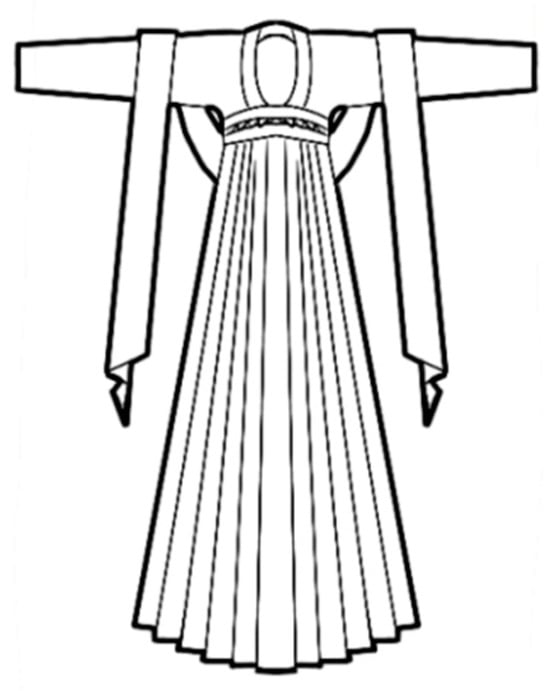
Figure 2.
Clothing style.
Due to the inability to measure through physical objects, this article uses image measurement method to determine the size specifications of each part by comparing the proportional relationship between the size of the character and the size of the clothing. Due to the slight backward tilt and downward movement of the original figure, in order to facilitate measurement, the lady figure was rotated appropriately and the height reference line was raised. The proportional relationship between various parts of the clothing and the human body after measurement is shown in Figure 3.
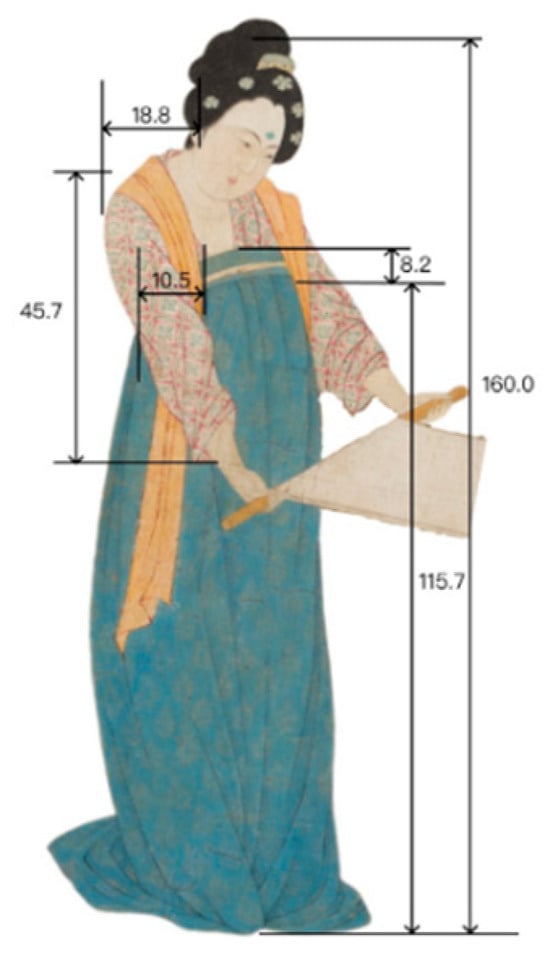
Figure 3.
Proportional relationship.
3.3.1. Upper Robe
Because of the gradual increase in female body shape, clothing styles tend to be looser and more obese, and the style of the upper robe has also changed, from tight and short in the early Tang Dynasty to gradually wide and fat.
Referring to the relevant records in the paper “Research on Tang Dynasty Costume Culture” [15] and through measurement and calculation, the length of the upper robe is set to 53 cm, the circumference is set to 92 cm, and there is a 3 cm collar spliced together to form a finished garment body, resembling a straight collar that converges with the garment towards the chest, presenting a semi concealed and semi exposed effect. The sleeves are a relatively loose style without excessive closure treatment. Based on measurement and calculation, the sleeve length is approximately 49.6 cm. Due to being rolled up, the length is appropriately increased to 55 cm. The width of the sleeve is approximately 19 cm, and the width of the cuff is set to 15 cm.
3.3.2. Lower Skirt
The lady in the painting is wearing a semi open chest dress, which is a popular high-waisted “pleated skirt” in the Tang Dynasty. The long skirt reaches the ground and covers the shoes, and at the same time, there is a stacking phenomenon in the lower skirt in the painting, so the skirt length should be appropriately increased to 125 cm. Because of the gradual increase in clothing materials at that time, the width of the skirt could reach more than 3 m. In the painting, the front of the lower skirt of the lady has 4 pleats, and the entire skirt has a total of 12 pleats, so the width of the skirt was set at 360 cm. The waist bundle of the skirt is measured and calculated to have a width of 8 cm and a length of 92 cm.
3.3.3. Draped Silk
The earliest draped silk is said to have evolved from the colorful ribbons on women’s clothing in the Sassanid Empire of Persia. This culture was transmitted eastward and combined with Buddhism. Later, during the Sui and Tang dynasties, the practice of worshipping Buddha became popular, and the graceful and lively feeling of silk attracted thousands of women, becoming a popular combination at that time. According to records, the length of the silk is mostly over 2 m [16]. Here, the length of the draped silk is settled as 210 cm and the width as 15 cm. The overall size specifications of the clothing are shown in Table 2.

Table 2.
Size of various structural parts of clothing.
4. Digital Restoration of Ladies’ Costumes
The restoration of ladies’ costumes is based on the appearance shown in the “ramming & washing silk painting” as a reference, supplemented by Tang Dynasty clothing culture, and using digital technology as a means, including clothing and makeup. The restoration of clothing is completed using CLO Standalone 7.3, involving structure, fabric, color, pattern, etc. This can be achieved using CLO 3D’s parameterized human body modeling, multi-dimensional clothing production, virtual fitting and other functions. Restoration includes the restoration of makeup, hairstyle, and accessories. The makeup part is drawn using Adobe Photoshop 25.0 image processing software, and the makeup appearance is changed by drawing virtual model skin textures. The accessories are made using Blender 4.3, an open-source 3D modeling software, and then imported into CLO 3D for rendering. In addition, this study also attempted to use the latest AI technology to assist in the restoration of patterns, verifying the effectiveness of emerging digital technologies in conjunction with the restoration process.
4.1. Clothing Restoration
4.1.1. Fabric Identification
During the Tang Dynasty, women’s clothing was mainly made of silk fabric. From the perspective of restoring clothing, the upper robe and lower skirt of the ladies’ clothing are well crafted, with colorful fabrics and exquisite patterns. Considering the status of the ladies and their family background, the fabric should be a luxurious silk fabric—a brocade. Due to its thick texture and the ability to perfectly present colors and patterns, it was deeply loved by the aristocrats at that time.
The use of yarn makes clothing light and dynamic overall. Yarn is a very lightweight, semitransparent fabric with high aesthetic and decorative value, commonly used in shirts, jackets, and draped fabrics. Yarn is divided into two categories: plain yarn and jacquard. The wearer will choose elegant plain yarn or noble and gorgeous jacquard yarn for clothing matching according to different scenes [17]. The draped silk of the lady in the painting is made of jacquard yarn, which is draped over her shoulders and wrapped around her arms to create a lively and elegant feeling.
By utilizing the fabric “Attribute Editor” in the CLO 3D software, we set the relevant attributes of the upper robe, lower skirt, and draped silk, as shown in Table 3, to conduct virtual simulation of the fabric. Subsequently, pattern recognition and restoration was used to create a continuous texture map of the fabric as four directions, completing the identification and design of the fabric.

Table 3.
Fabric attribute.
4.1.2. Color Matching
The color system of women’s clothing in the Tang Dynasty mainly adopted a combination of contrasting colors and a coordinated color, thus forming a unique color combination. In this design, the contrast between cool and warm colors is often cleverly incorporated, creating a rich and harmonious visual effect for the clothing. During the prosperous Tang Dynasty, women’s clothing often used bright red colors such as orange, vermilion, crimson, eosin, or other warm colors, with contrasting colors such as sky blue and light blue as the main light tones.
In the “ramming & washing silk painting”, the lady on the left wears an upper robe with a pink background, a lake blue lower skirt, and an orange draped silk on her shoulders. The visual stimulus of the color of this suit lies in the use of the contrast color between the lower skirt and the draped silk. The clever collision of cool and warm colors makes the whole suit both romantic and beautiful, simple and calm, giving a sense of balance and comfort. In addition, the Tang Dynasty liked to use warm and bright colors as embellishments for the clothing overall, making it more dazzling. Therefore, the pattern color was chosen to be yellow, which better matched the clothing overall.
4.1.3. Pattern Restoration
The main features of clothing patterns in Tang Dynasty are round and smooth shapes, dense compositions, complex rhythms, and dramatic momentum [17]. The most representative patterns include Baoxiang patterns, peony patterns, curled grass patterns, and entwined branches patterns. Observing the “ramming & washing silk painting”, it is difficult to clearly determine the pattern features of the lower skirt and draped silk. This article uses computer image processing and AI tools for pattern restoration. This study will first use AI tools to magnify local patterns for subsequent algorithms to clearly identify complex patterns. The results obtained through computer recognition will then be manually modified in conjunction with costume culture to ultimately obtain authentic and reliable patterns.
Firstly, we used the AI image inpainting tool Upscayl to enlarge the image and complete the pixels.
We imported the restored image of the lady into Upscayl, selected the ULTRA SHARP model, removed noise and enlarged the image to make the patterns clearer and more visible. A comparison of the original image and the sharpened image is shown in Figure 4.
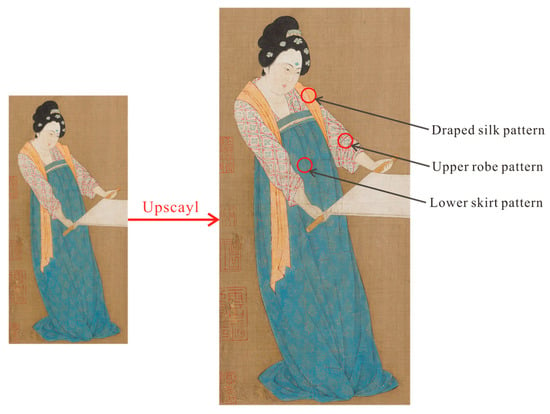
Figure 4.
A comparison of AI image restoration before and after.
Secondly, using Python 3.8 programming tools, the Canny algorithm, which is an edge-detection algorithm proposed by John F. Canny in 1986, was applied to extract pattern information from the lower skirt. The Canny algorithm is widely used in the field of image processing, especially in digital restoration, computer vision, and pattern recognition. The Canny algorithm is known for its high accuracy, low error rate, and good edge continuity, making it highly suitable for edge detection in complex images such as ancient clothing patterns [18].
Canny edge detection mainly restores images through five steps: Gaussian filtering, gradient calculation, non maximum suppression, dual-threshold detection, and edge connection. The main purpose of Gaussian filtering is to suppress noise in the image and avoid it being mistakenly identified as edges in subsequent gradient calculations. Noise is usually manifested as high-frequency signals, while Gaussian filtering reduces the influence of high-frequency components by smoothing the image. The high-frequency noise in the image processed by Gaussian filtering is suppressed, and the main edge structures are preserved. The purpose of gradient calculation is to capture changes in pixel intensity in an image, in order to identify potential edges. Edges typically exhibit significant changes in pixel intensity, with larger gradient amplitudes indicating higher edge intensity. The edge regions in the image are highlighted through gradient calculation The purpose of non maximum suppression is to refine the edges and compress the edge width to the single pixel level. By preserving the local gradient maximum along the gradient direction and suppressing non maximum pixels, the width of the edges can be reduced. The edge width of the image after non maximum suppression processing is compressed to the single pixel level, resulting in clearer edges The purpose of dual-threshold detection is to distinguish strong edges, weak edges, and non edges, and reduce the interference of false edges. By setting high and low thresholds, edge pixels are classified into strong edges, weak edges, and non edges. After dual-threshold detection, strong edges in the image are directly retained, weak edges need further verification, and non edges are removed. The purpose of edge connection is to ensure the continuity of the edges and avoid edge breakage. By connecting weak and strong edges, a complete edge structure is formed. Finally, the isolated weak edges are connected to the strong edges to form a complete edge structure, completing the clear and prominent edges of the image.
Figure 5 shows the process and results of the Canny algorithm for the lower skirt pattern, which has a narrow upper and wide lower shape. After identification, it was determined to be a combination of curled grass patterns and flowers, with the popular Tang Dynasty Baoxiang flower as the middle part, surrounded by curled grass patterns. Baoxiang flower is a classic Tang Dynasty floral pattern with a complex and diverse structure based on lotus flowers [19], while curled grass patterns are freer and more flexible, unpredictable. The restoration of the lower skirt pattern is shown in Figure 6.
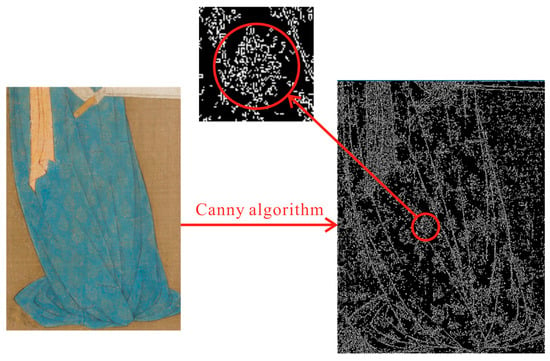
Figure 5.
Processing and results of the Canny algorithm for the lower skirt pattern.
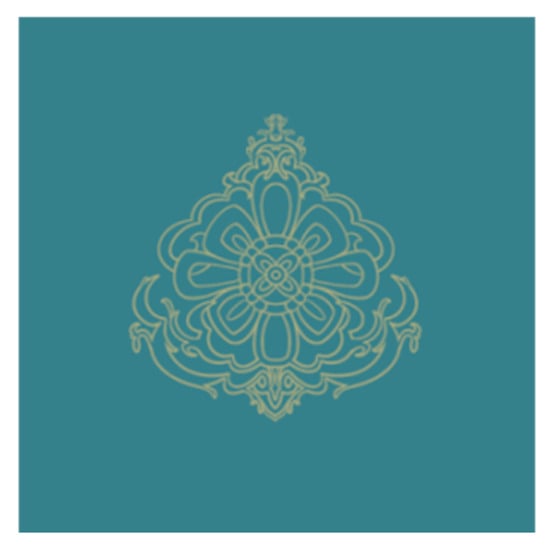
Figure 6.
The lower skirt pattern.
Once again, by comparing the details of the AI-repaired patterns and referring to other silk patterns of ladies in the “ramming & washing silk painting” and the book “Ancient Chinese Silk Design Material Series” [20], the AI recreative restoration of the draped silk patterns was performed and determined to be a combination of grid patterns and cluster patterns, as shown in Figure 7.
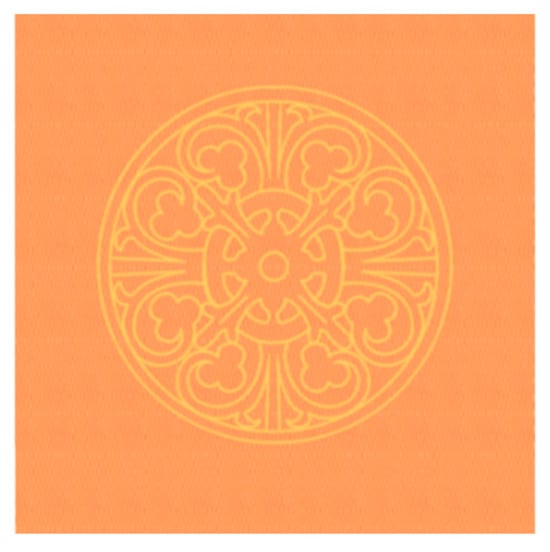
Figure 7.
The draped silk pattern.
Finally, by observing the AI-repaired upper robe pattern, it was determined to be a diamond-shaped floral pattern. Clear pattern references can be found in the book “Ancient Chinese Silk Design Material Series”, with pink as the base and each edge of the diamond grid consisting of two leaves, filled with a radial symmetrical auspicious flower, and surrounded by an ivory white halo. The pattern composition is simple, the color matching is elegant, and the style is peaceful and beautiful, as shown in Figure 8.
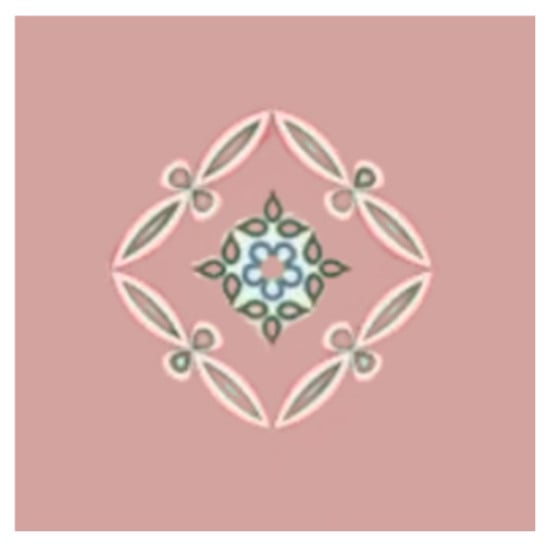
Figure 8.
The upper robe pattern.
4.1.4. Restoration Results of the Clothing
Based on the above analysis and research, the clothing patterns including upper robe, lower skirt, and draped silk are made by a pattern design system (PDS), which is an application of the Richpeace CAD V8A software, and stored in DXF format. We imported the clothing patterns into CLO 3D design software, and performed 3D digital restoration of the clothing through functions such as pattern filling, 3D arrangement, virtual stitching, fabric simulation, and combination wearing. The restoration result is shown in Figure 9.
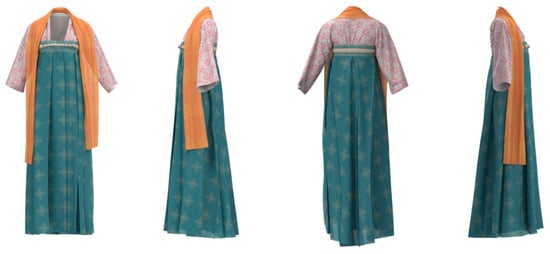
Figure 9.
Digital restoration of the clothing.
4.2. Makeup Restoration
Makeup was another major element for Chinese ancient women to express beauty. The book “Makeup in the Spring and Autumn Period: Chinese Dynasties” divides makeup into three parts: facial makeup, hairstyle, and hair accessories. Makeup showcases the artistic cultivation and aesthetic taste of women in the Tang Dynasty.
4.2.1. Facial Makeup Restoration
The facial makeup of the ladies in “ramming & washing silk painting” refers to the most popular red makeup in the Tang Dynasty. Compared with the bright red makeup in other ladies’ paintings, the facial makeup of the ladies in “ramming & washing silk painting” is relatively light, and there is a faint red color at the corners of the eyes, which seems to be combined with peach blossom makeup. During the prosperous Tang Dynasty, flowing eyebrow makeup with light colors and long and thin shapes was popular, mainly consisting of moth eyebrows, distant mountain eyebrows, indigo eyebrows, and willow leaf eyebrows. This article selects willow leaf eyebrows as a reference, which have a slender eyebrow shape and can express the facial expressions of ladies. The shape of lip makeup is favored by cherry lips and small, round lips. In the Tang Dynasty, lip balm used for dotting lips also had a certain shape, as recorded in Yuan Zhen’s “Biography of Yingying” as “five inches of lip balm”. Furthermore, the lady’s forehead was adorned with an inlay of lime green Hua Dian, in addition to the then-popular facial decorations, often featuring flowers in red, green, yellow and other colors. Observing the Hua Dian worn by the ladies in the “ramming & washing silk painting”, they are mostly smooth and dull, and the flower shapes are directly drawn using pigments, with colors that correspond to the clothing colors. We used the virtual model skin surface texture provided by CLO 3D software, exported relevant PNG format files, and used image processing Adobe Photoshop to draw makeup. Figure 10 depicts the restoration of the facial makeup.

Figure 10.
Restoration of makeup.
4.2.2. Hairstyle Restoration
During the Tang Dynasty, women demonstrated a high level of innovation in their hairstyles. Taking the most common hair bun as an example, there were dozens of styles such as the Yun bun, the Bao bun, the Jinghu bun, and the Fallen Horse bun. In the early Tang Dynasty, hair buns were relatively flat, but after the prosperous Tang Dynasty, high buns became popular [21].
In the painting “ramming & washing silk painting”, the hair buns of the ladies are all high buns, belonging to the style of Bao buns, either tied on the top of the head or combed at the back of the head. In addition, ladies also have sideburns, which are the hair below the forehead and in front of the ears, to enhance the beauty of buns. Among them, cicada sideburns are the most vibrant sideburns in Chinese women’s hairstyles, which are very dynamic. We used Blender modeling software to create hairstyles and hair accessories and carving tools to display textures, imported appropriate textures to make the model more realistic, saved the model as an Obj format file and imported it into CLO 3D. Hairstyle restoration is shown in Figure 10.
4.2.3. Hair Accessories Restoration
The Tang Dynasty respected Confucian culture, and Chinese Han people rarely wore earrings. In the painting “ramming & washing silk painting”, the ladies are engaged in production labor, and accessories such as bracelets and necklaces can affect normal activities and are inconvenient to wear. Therefore, only hair accessories are worn to enhance the beauty of the makeup.
During the Tang Dynasty, there were numerous hair accessories for ladies, including combs, hairpins, and rocking steps [22]. In the painting “ramming & washing silk painting”, many hair accessories were inserted into the front of the forehead of the ladies’ hair. Among them, the inserted comb not only combed the hair but also served as decoration. The inserted combs are commonly made of materials such as gold, silver, wood, rhinoceros’ horn, ivory, or jade, and are often triangular or curved, with a half-moon-shaped comb back exposed. Different patterns and designs are carved on the back of different hair combs, with plant patterns such as entwined branches, curled grass patterns, Baoxiang patterns, and clustered flowers dominating. In addition, there are flower decorations on the hair, usually made of gold, silver or fresh flowers. Considering the status of the ladies, precious metals are selected as the decorative materials to make the overall shape more gorgeous and exquisite. The restoration of the hair accessories is shown in Figure 10.
4.3. Overall Costume Restoration
After analyzing and establishing the character prototype, the virtual model editor in CLO 3D design software is used to adjust the virtual model’s body size according to the sizes shown in the Table 1, and its posture and motion are adjusted using the “X-Ray Joint”.
Then the restored clothing shown in Figure 9 was added to the virtual model, and facial makeup, hairstyle, and hair accessories were applied. We improved the simulation quality and performed unified rendering.
After adjusting the lighting, background, and angle, the digital restoration effect of the lady’s costume is shown in Figure 11.
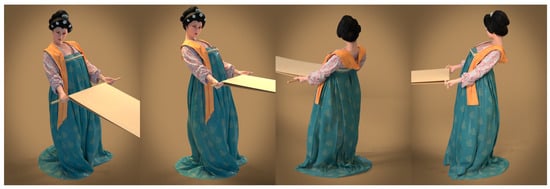
Figure 11.
Digital restoration effect of the lady’s costume.
5. Conclusions
In order to quickly and effectively carry out the digital restoration of traditional costumes, this study takes ladies’ costume in Zhang Xuan’s painting “ramming & washing silk painting” as the restoration object, combines AI & 3D digital and intelligent technology with costume culture, and conducts digital restoration research on Tang Dynasty ladies’ costumes from multiple perspectives such as characters, clothing, and makeup.
Firstly, the identity and physical characteristics of the lady are ascertained through clarifying the historical background depicted in the painting, which lays the foundation for costume restoration. By using an image measurement method, the detailed dimensions of the upper robe, lower skirt, and draped silk are determined by comparing the proportional relationship between the characters and clothing.
Secondly, clothing digital restoration is completed through fabric identification, color matching, and pattern restoration. The restoration of patterns is carried out using AI intelligent technology and edge-detection algorithms for image restoration, information extraction, and AI regeneration. At the same time, pattern elements are identified based on Tang Dynasty costume culture for pattern restoration.
Once again, by comparing the original images and utilizing image processing, 3D modeling, and AI generation techniques, the restoration of facial makeup, hairstyle, and hair accessories is achieved. On this basis, 3D digital technology was applied to fully restore the costume of the lady on the left in the painting “ramming & washing silk painting”.
This research has found that in-depth analysis of costume culture can accurately identify the characteristic composition of elements such as the structure, color, and pattern in restored clothing; AI & 3D digital intelligent technology can quickly and effectively achieve pattern restoration and regeneration, as well as 3D modeling and digital restoration of costumes.
This study took one week from the beginning of restoration to the production of results, with extremely low cost and perfect implementation of the principles of accuracy, reversibility, sharing, and ethics of virtual restoration. All models, images, and code were converted into digital resources and saved for reuse or further in-depth research. Compared with traditional restoration or other types of digital restoration, this is more efficient and accurate. In addition, this study constructed a systematic process for traditional clothing restoration, which follows the research logic of emphasizing both the clothing overall and the details. Guided by the cultural connotation of clothing, this process integrates multiple digital technologies such as 3D modeling, artificial intelligence-assisted image processing, and virtual display, forming a complete methodological system for digital restoration of traditional clothing. This process provides replicable and scalable technical solutions for digital protection of traditional culture.
This research plan provides a feasible reference for using digital and intelligent technology combined with costume culture to digitally restore traditional costumes in the era of artificial intelligence. This research comprehensively and efficiently restored a Tang Dynasty lady’s costume based on the “ramming & washing silk painting”, which has certain practical significance for the inheritance and innovative development of traditional costumes. By conducting research on the digital restoration of characters, clothing, and makeup, not only has the efficiency and accuracy of restoration been improved, but relevant digital resources have also been constructed to provide support for costume appreciation and dissemination in the information age.
Author Contributions
G.Z. developed the research idea and wrote part of this manuscript. Y.L. made patterns, performed 3D modelling and wrote part of this manuscript. S.Z. collected costume information and performed 3D modelling. All authors have read and agreed to the published version of the manuscript.
Funding
The work was financially supported by the Social Science Fund Project of Guangdong Province, China (No. GD24CYS26).
Data Availability Statement
The data used to support the findings of this study are available from the corresponding author upon request.
Conflicts of Interest
The authors declare no conflicts of interest.
References
- Xu, X.; Wang, L. Structural Analysis and Restoration of Ming Dynasty Taoist Robes. J. Fash. 2023, 8, 384–390, 399. [Google Scholar]
- Cheng, P.; Chen, D.; Chen, D. Research on the Shape and Structural Restoration of Modern Folk Robes. Silk 2015, 4, 42–47. [Google Scholar]
- Albu, A.V.; Caciora, T.; Berdenov, Z. Digitalization of garment in the context of circular economy. Indusria Textila 2021, 1, 102–107. [Google Scholar] [CrossRef]
- Yu, L. The Digital Innovation Application of Dunhuang Algae Well Patterns in Fashion Design. Woolen Technol. 2022, 9, 45–53. [Google Scholar]
- Liang, H.; Li, D. Reflection on the Exhibition and Digital Construction of Clothing Accessories in Museums in the Jiangnan Region—Taking Headwear Collections as an Example. Grand View Art 2020, 10, 134–135. [Google Scholar]
- Qu, L. The application of digital technology in cultural relic restoration. Collection 2023, 8, 119–121. [Google Scholar]
- Liu, K.; Li, X.; Zhu, C. Research on the Restoration of Ladies’ Clothing in the Painting of Hairpin Flowers. Silk 2022, 5, 59–67. [Google Scholar]
- Zhu, G.; Zhang, W. The three-dimensional digital restoration of Hakka cardigan and its effect evaluation. J. Guangdong Univ. Technol. 2023, 2, 129–134. [Google Scholar]
- Lin, C. Research on the Shape and Digital Restoration of Ancient Chinese Music and Dance Costume. Master Dissertation, Zhejiang Sci-Tech University, Hangzhou, China, 2021. [Google Scholar]
- Zhu, C.; Liu, K.; Li, X. Research on Archaeology and Digital Restoration of Costumes in DaoLian Painting. Sustainability 2022, 14, 14054. [Google Scholar] [CrossRef]
- Qiao, W. Research on Archaeology and Digital Restoration of Clothing in Qing Dynasty literati Paintings. Color 2023, 8, 44–47. [Google Scholar]
- Qin, S. Interpretation of the Beauty of Costume in Tang Dynasty Ladies Paintings. Grand View Art 2016, 10, 78–79. [Google Scholar]
- Sun, L.; Zhu, H. A Study on the Height of Adult Residents of Han, Tang, and Song Dynasties in Zhengzhou Area. J. Anthropol. 2015, 3, 377–389. [Google Scholar]
- Lan, Y. Research on Tang Dynasty Clothing Culture; Shanxi People’s Fine Arts Press: Xi’an, China, 2017. [Google Scholar]
- Liang, Y. A Study on the Makeup of Tang Dynasty Ladies Paintings. Master Dissertation, Qufu Normal University, Qufu, China, 2021. [Google Scholar]
- Zhang, C. A Study on Women’s Clothing in Tang Dynasty Ladies Paintings. Master Dissertation, Yangzhou University, Yangzhou, China, 2022. [Google Scholar]
- Zhang, X. The Plant Decorative Patterns on Tang Dynasty Textiles. Silk 2007, 6, 49–52. [Google Scholar]
- Liu, N.; Ma, Y.; Shao, L.; Wang, H. Rapid Extraction of Clothing Sample Profile Based on the Improved Canny Algorithm. Adv. Multimed. 2022, 4, 7554652. [Google Scholar] [CrossRef]
- Wang, K.; Liang, Y.; Hu, K. Innovative Design of Baoxiang Flower Pattern of the Tang Dynasty in China-Chic Clothing. J. Fash. 2023, 1, 64–73. [Google Scholar]
- Yuan, X. Ancient Chinese Silk Design Material Series: Image Volume; Zhejiang University Press: Hangzhou, China, 2016. [Google Scholar]
- Li, Y. Lipstick Autumn and Spring—Chinese Cosmetics All Through the Years; China Textile Press: Beijing, China, 2015. [Google Scholar]
- Li, Z. Research on Design and Craft of Female Hair Ornaments in Tang Dynasty. Master Dissertation, Beijing Institute of Fashion Technology, Beijing, China, 2022. [Google Scholar]
Disclaimer/Publisher’s Note: The statements, opinions and data contained in all publications are solely those of the individual author(s) and contributor(s) and not of MDPI and/or the editor(s). MDPI and/or the editor(s) disclaim responsibility for any injury to people or property resulting from any ideas, methods, instructions or products referred to in the content. |
© 2025 by the authors. Licensee MDPI, Basel, Switzerland. This article is an open access article distributed under the terms and conditions of the Creative Commons Attribution (CC BY) license (https://creativecommons.org/licenses/by/4.0/).